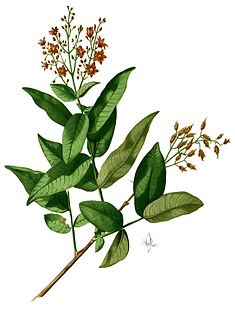
Vallaris is a genus of plants in the family Apocynaceae first described as a genus in 1768. It is native to China, the Indian Subcontinent, and Southeast Asia.
- Vallaris anceps = Kibatalia macrophylla
- Vallaris angustifolia = Kibatalia gitingensis
- Vallaris arborea = Kibatalia macrophylla
- Vallaris clavata = Echites clavatus
- Vallaris daronensis = Kibatalia maingayi
- Vallaris divaricata = Strophanthus divaricatus
- Vallaris fimbriata = Euphorbia mammillaris
- Vallaris gitingensis = Kibatalia gitingensis
- Vallaris ipecacuanhae = Euphorbia ipecacuanhae
- Vallaris lancifolia = Vallariopsis lancifolia
- Vallaris laxiflora = Pottsia laxiflora
- Vallaris macrantha = Beaumontia macrantha
- Vallaris maingayi = Kibatalia maingayi
- Vallaris missurica = Euphorbia missurica
- Vallaris portulacoides = Euphorbia portulacoides
- Vallaris × uniflora = Euphorbia × uniflora

Cratoxylum is a genus of flowering plants in the family Hypericaceae, native to tropical Asia. The generic name is from the Greek meaning "strong wood", referring to the timber.

Cratoxylum maingayi is a plant in the family Hypericaceae. It is named for the botanist Alexander Carroll Maingay.

Kibatalia is a genus of trees and shrubs in the family Apocynaceae, tribe Malouetieae, first described as a genus in 1826. It was initially called Hasseltia, but this turned out to be an illegitimate homonym. So Kibatalia was chosen as a replacement name. Kibatalia is native to China and Southeast Asia.
- Kibatalia arborea(Blume) G.Don – Thailand, Philippines, W Malaysia, Borneo, Sumatra, Java, Sulawesi
- Kibatalia blancoi(Rolfe ex Stapf) Merr. – Philippines
- Kibatalia borneensis(Stapf) Merr. – Sarawak
- Kibatalia elmeriWoodson – Luzon
- Kibatalia gitingensis(Elmer) Woodson – Philippines
- Kibatalia laurifolia(Ridl.) Woodson – Vietnam, Cambodia, Thailand, W Malaysia
- Kibatalia longifoliaMerr. – Mindanao
- Kibatalia macgregori(Elmer) Woodson – Sibuyan
- Kibatalia macrophylla(Pierre ex Hua) Woodson – Yunnan, Indochina
- Kibatalia maingayi(Hook.f.) Woodson – Thailand, W Malaysia, Borneo, Sumatra, Mindanao
- Kibatalia merrillianaWoodson – Leyte, Samar
- Kibatalia puberulaMerr. – Samar in Philippines
- Kibatalia stenopetalaMerr. – Luzon, Dinagat, Mindanao
- Kibatalia villosaRudjiman – W Malaysia, Borneo
- Kibatalia wigmani(Koord.) Merr. – Sulawesi
- Kibatalia africana(Benth.) Merr. = Funtumia africana(Benth.) Stapf
- Kibatalia elastica(Preuss) Merr. = Funtumia elastica(Preuss) Stapf
- Kibatalia latifolia(Stapf) Merr. = Funtumia africana(Benth.) Stapf
- Kibatalia scheffieri(K.Schum.) Merr. = Funtumia africana(Benth.) Stapf
- Kibatalia zenkeri(K.Schum.) Merr. = Funtumia africana(Benth.) Stapf
Ochrosia glomerata is a species of tree in the family Apocynaceae.

Tabernaemontana pandacaqui, known as windmill bush and banana bush, is a species of plant in the dogbane family Apocynaceae.
Tabernaemontana pauciflora is a species of plant in the family Apocynaceae. It grows as a shrub or small tree up to 6 metres (20 ft) tall, with a trunk diameter of up to 10 centimetres (4 in). The bark is pale grey to grey-brown. Inflorescences bear up to 15 flowers. The fragrant flowers feature white, sometimes yellow-throated, corolla lobes. The fruit is orange or yellow with paired follicles, up to 6 centimetres (2 in) in diameter.

Kibatalia arborea is a tree in the dogbane family Apocynaceae.
Voacanga havilandii grows as a small tree up to 15 metres (50 ft) high, with a trunk diameter of up to 15 centimetres (6 in). The bark is pale green to whitish. Its flowers feature a white or cream corolla. The fruit is up to 5 cm (2 in) in diameter. Its habitat is lowland forest from sea level to 200 metres (700 ft) altitude. V. havilandii is endemic to Borneo.
Gonystylus maingayi is a tree in the family Thymelaeaceae.
Chionanthus callophyllus grows as a tree up to 30 metres (100 ft) tall, with a trunk diameter of up to 30 centimetres (12 in). The bark is white, grey or brown. The flowers are pale green or white. Fruit is purple and round, up to 2.5 centimetres (1 in) in diameter. The specific epithet callophyllus is from the Greek meaning "beautiful leaf". Habitat is lowland forest, sometimes in swamps, from sea-level to 500 metres (1,600 ft) altitude. C. callophyllus is found in Thailand, Malaysia and Indonesia.
Ligustrum glomeratum is a plant in the family Oleaceae. The specific epithet glomeratum means "gathered closely", referring to the flowers.
Olea brachiata grows as a shrub or small tree up to 10 metres (30 ft) tall, with a stem diameter of up to 5 centimetres (2 in). The twigs are pale brown. The flowers are dull white. Fruit ripens to purple-black. The specific epithet brachiata is from the Latin meaning "branched", referring to the decussate inflorescence. O. brachiata is native to China, Thailand, Cambodia, Vietnam, Malaysia and Indonesia.
Isonandra lanceolata is a plant in the family Sapotaceae. The specific epithet lanceolata means "spear-shaped", referring to the leaves.
Diospyros maingayi is a tree in the family Ebenaceae. It grows up to 30 metres (100 ft) tall. The twigs dry black. Inflorescences bear up to four flowers. The fruits are oblong to ellipsoid, up to 5 cm (2 in) long. The tree is named for British botanist A. C. Maingay. Habitat is peat swamp and other lowland forests. D. maingayi is found in Sumatra, Peninsular Malaysia and Borneo.
Alangium kurzii is a tree in the family Cornaceae. It is named for the German naturalist Wilhelm Sulpiz Kurz.
Clethra canescens var. clementis is a tree in the family Clethraceae.
Clethra pachyphylla is a tree in the family Clethraceae. The specific epithet pachyphylla is from the Greek meaning "thick leaves".
Ceriops decandra is a mangrove plant of tropical Asia in the family Rhizophoraceae. The specific epithet decandra is from the Greek meaning "ten male", referring to the flower having ten stamens.

Mitrephora maingayi is a species of plant in the family Annonaceae. It is native to Bangladesh, Borneo, Cambodia, Laos, Peninsular Malaysia, Myanmar, Sumatra, and Vietnam. Joseph Hooker and Thomas Thomson, the British botanists who first formally described the species, named it in honor of Alexander Carroll Maingay, the British botanist who collected the specimen they examined.






